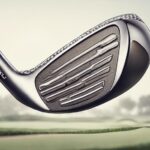- 7 Top Flite Golf Clubs XL for Improved Performance - September 28, 2024
- Top Flite Golf Clubs: Top 5 Reasons to Choose Them - September 28, 2024
- Top 3 Golf Club Fitters for a Perfect Swing - September 28, 2024
You carry 14 golf clubs, each designed for specific distances and scenarios, but do you know which one to choose for the shot you're facing? Your driver is for long-distance shots off the tee, with loft angles ranging from 8-13 degrees. Wedges have higher loft angles, helping you maneuver obstacles and get the ball airborne. Hybrids combine features of fairway woods and irons for accuracy, distance, and versatility. Knowing which club to use and how to use it is key to achieving the desired outcome. Take the next step in refining your golf game and explore the nuances of each club to elevate your performance.
Key Takeaways
- Choose a driver based on your swing preferences and performance needs, considering loft angle and offset or draw characteristics.
- Select the right wedge for high-angle shots by considering distance to the pin, lie of the ball, and obstacles, and practice with each wedge for accuracy.
- Hybrids offer forgiveness, distance, and control, combining the accuracy of irons with the power of woods, making them ideal for golfers seeking improvement.
- Consider factors like putter length, head design, and loft to find a comfortable and suitable putter that matches your individual putting style.
- Consider your playing style, skill level, and preferences when choosing clubs, focusing on forgiveness, distance, and control, and testing clubs before purchasing.
Understanding Golf Clubs
When you step onto the golf course, you're armed with a bag of 14 clubs, each meticulously designed to tackle specific distances and scenarios. To master your game, it's crucial to understand the unique characteristics of each club and when to use them.
The club to use depends on the shot you're facing, and selecting the right one can make all the difference. Drivers, with their low loft angle, are ideal for long-distance shots off the tee. On the other hand, wedges, with their higher loft angle, help get the ball airborne and are perfect for maneuvering obstacles. Hybrids, which blend the features of fairway woods and irons, offer accuracy, distance, and versatility.
As you progress through the course, you'll encounter different clubs suited for specific tasks. Understanding the strengths and weaknesses of each club will help you make informed decisions about which club to use in various situations.
Choosing the Right Driver
With a solid understanding of your overall club selection, you can now focus on the most critical club in your bag – the driver, which demands careful consideration due to its unique characteristics and the significant impact it has on your game. As the longest club in your bag, drivers are designed for distance off the tee, with loft angles ranging from 8-13 degrees.
| Driver Type | Loft Angle | Benefits |
|---|---|---|
| Standard | 9-10 degrees | Suitable for most golfers, providing a balance of distance and accuracy |
| Offset | 10-11 degrees | Helps correct slicing tendencies, ideal for beginners or those with an open swing |
| Draw | 11-12 degrees | Designed for golfers with a closed swing, promoting a more controlled draw |
When choosing a driver, consider your swing preferences and performance needs. Higher loft drivers are easier to hit, but may sacrifice distance. Demoing drivers at a golf resort can help you find the perfect fit. With the right driver, you'll be able to unveil your full potential off the tee, setting yourself up for a successful round.
Wedges for High-Angle Shots
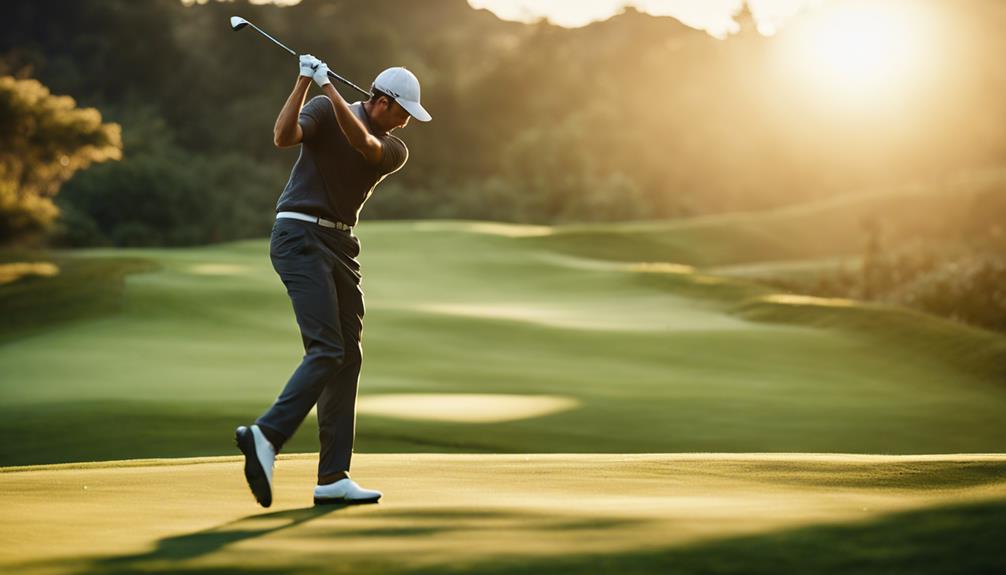
When you need to tackle high-angle shots, the right wedge can make all the difference. You'll want to master the art of selecting the perfect wedge for the job, considering factors like loft angle and bounce to get out of tricky situations safely.
High Angle Mastery
Mastering high-angle shots requires a deep understanding of wedges, the specialized clubs designed to help you maneuver challenging lies and pin-point targets with precision. You need to know when to use the right wedge for the job. Here's a breakdown of the different types of wedges and their ideal uses:
| Wedge Type | Loft Angle | Ideal Use |
|---|---|---|
| Pitching Wedge | 46-48° | Shots 50-120 yards from the green |
| Sand Wedge | 54-56° | Escaping bunkers and thick rough |
| Lob Wedge | 60-64° | High, soft-landing shots close to the green |
Understanding the loft angle of your wedges is essential for achieving the right trajectory. For example, a lob wedge with a loft angle of 62° will give you a higher, softer landing shot than a pitching wedge with a loft angle of 48°. Additionally, the bounce angle of your wedge plays a significant role in maneuvering various course conditions. By mastering your wedges, you'll be able to tackle even the toughest high-angle shots with confidence. Remember, the key to success lies in understanding when to use each wedge and how to optimize their performance.
Wedge Selection Tips
You'll need to carefully consider the distance to the pin, the lie of the ball, and the obstacles in your path to choose the right wedge for high-angle shots, as each type of wedge is designed to excel in specific situations.
With high-angle shots, you're looking to get the ball up quickly and land it softly on the green. For shots approaching the green, your pitching wedge with its 45-degree loft angle is a great option.
However, if you're faced with a high lip or deep bunker, you'll need something with more loft. That's where your sand wedge comes in, designed to help you escape tricky lies.
For even more extreme situations, you might need a lob wedge with its steep loft angle of up to 64 degrees. Remember, the key to success lies in selecting the right wedge for the job.
Pay attention to the bounce angle on the sole, too, as it'll help you maintain clean contact with the ball, even in sand or rough. By choosing the right wedge, you'll be well on your way to mastering high-angle shots.
Getting Out Safely
Getting out safely from high-angle lies or bunkers demands a solid understanding of wedge selection, as the right club can make all the difference between a respectable recovery shot and a disastrous retry.
When faced with high-angle shots, you need to choose the right wedge to get out safely and set yourself up for a successful next shot. Here are some key considerations to keep in mind:
- Know your wedges: Familiarize yourself with the different types of wedges, including pitching, gap, sand, and lob wedges, each designed for specific situations.
- Loft matters: Understand the varying degrees of loft offered by each wedge, such as 45 degrees for pitching wedges and up to 64 degrees for lob wedges.
- Choose the right club: Select the wedge that best suits the specific situation you're facing, taking into account the height and distance you need to achieve.
- Practice makes perfect: Develop your skills with each wedge to gain confidence and accuracy in high-angle shots.
- Pay attention to course conditions: Adapt your wedge selection to the course's terrain, taking into account factors like sand, grass, and obstacles.
Hybrids for Distance and Control
As you step up to the tee, you're looking for a club that can deliver both distance and control. That's where hybrids come in, offering a unique blend of forgiveness and power that can help you hit more accurate shots.
Hybrid Club Benefits
Hybrids have revolutionized the game by offering a unique blend of forgiveness, distance, and control, making them an attractive option for golfers seeking to improve their overall performance.
You'll find that hybrids combine the best of both worlds, providing the accuracy of irons and the power of woods.
Here are just a few benefits you can expect from using a hybrid club:
- Higher spin rates and softer landings, leading to enhanced accuracy and control on the course
- Ease of use and versatility in various situations, making them a popular choice over traditional long irons
- A balanced combination of distance and control, thanks to the design that combines a fairway wood head with an iron length shaft
- A reliable option for bridging the gap between long irons and fairway woods
- Forgiveness and distance, making them ideal for golfers looking to improve their overall game
Accurate Distance Shots
You'll consistently hit accurate distance shots with hybrids, which deliver the perfect blend of power and control, allowing you to reach your target with precision and confidence. By combining the forgiveness of irons with the distance of woods, hybrids provide accuracy and distance, making them an ideal choice for golfers seeking mastery.
Here's a breakdown of how hybrids compare to fairway woods and long irons:
| Club Type | Forgiveness | Distance | Ease of Use |
|---|---|---|---|
| Fairway Woods | Low | High | Medium |
| Long Irons | Low | Medium | Low |
| Hybrids | High | High | High |
| Hybrids (vs. Fairway Woods) | More Forgiving | Similar Distance | Easier to Use |
| Hybrids (vs. Long Irons) | More Forgiving | Longer Distance | Easier to Use |
Hybrids are designed to replace harder-to-hit long irons, offering a higher spin rate and softer landing, which many golfers prefer. With their versatility and ease of use, hybrids can help you reach your target accurately in various situations on the course. By incorporating hybrids into your game, you'll experience a significant improvement in your distance shots, leading to increased confidence and a better overall game.
Putter Selection for Beginners
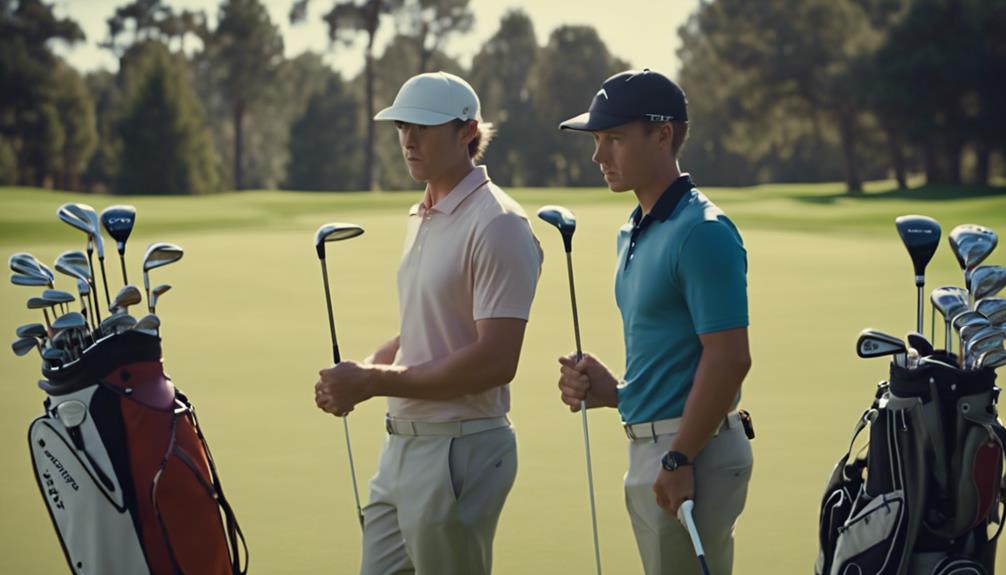
When stepping onto the green, selecting the right putter is vital for beginners, as it directly influences their ability to precision-putt and build confidence in their short game. With various styles and lengths available, finding the perfect putter can be overwhelming. Here are key factors to take into account for ideal putter selection:
- Putter Length: Most putters range from 33 to 35 inches, but custom options like Broomstick and Belly putters offer taller alternatives.
- Putter Head Design: The right head design, whether flat or mallet-shaped, can greatly impact putting accuracy and performance.
- Testing: Try out putters in-store to make sure comfort, alignment, and loft suit your putting style.
- Proper Loft: A putter with the right loft reduces ball bouncing, enhancing accuracy and control during important putting moments.
- Personal Preference: Ultimately, choose a putter that feels comfortable in your hands and suits your unique putting style.
Fairway Woods for Versatility
From the fairway to the rough, and even off the tee, fairway woods offer golfers a versatile club that can tackle a variety of shots and situations. As you navigate the course, you'll find that fairway woods provide a reliable option when you're unsure about club selection. With their ability to produce varying trajectories and distances, fairway woods are essential for approach shots and long fairway play.
The distance you can achieve with a fairway wood depends on your experience, skill, and clubhead speed. However, with the right loft angle, you can maximize your distance and accuracy. Fairway woods come in different loft angles, allowing you to choose the right club for your shot.
Whether you need to hit a high shot over trees or a low shot under the wind, fairway woods provide the versatility you need to succeed.
Irons for Approach Shots
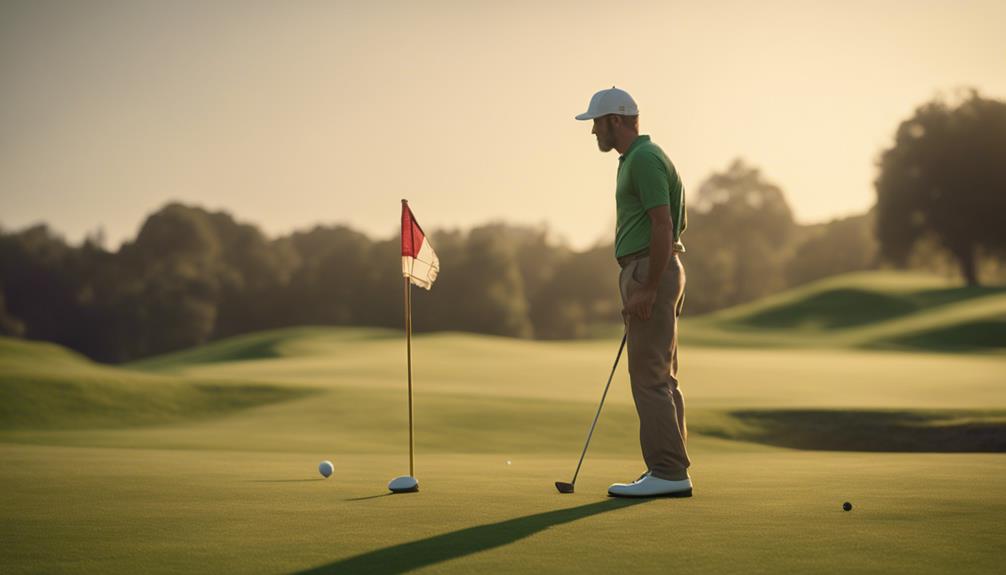
When you're within 200 yards of the green, it's time to bring out the irons.
You'll want to choose the right one for the distance and situation, as irons offer precision and control that drivers can't match.
Irons for Precision
As you step onto the course, you'll find yourself relying on irons to deliver precision approach shots, particularly when you're within 200 yards of the green. Your iron club is essential for playing golf at a high level, and selecting the right one can make all the difference.
Here are some key things to keep in mind when it comes to irons for precision:
- Irons are designed for accuracy, not distance, so focus on making solid contact rather than trying to hit the ball as far as possible.
- As you get closer to the green, you'll typically switch to a higher loft iron to get the ball airborne quickly and stop it fast on the green.
- Practice is key to mastering iron play, so make sure to spend time on the range honing your skills.
- Perimeter-weighted irons can be more forgiving and easier to hit, especially for beginners.
- Remember, precision is key with irons, so focus on making consistent, controlled swings to get the results you want.
With the right iron and a solid technique, you'll be sinking birdies in no time.
Irons for Control
You'll find that irons for control are specifically designed to help you navigate the challenging approach shots that demand precision and accuracy within 200 yards of the green. These irons offer more control and accuracy than drivers, making them essential for precise shots on the course. As you get closer to the green, you'll typically reach for higher-numbered irons, such as the 7-9 irons, which provide more height and spin.
Here's a breakdown of the key characteristics of irons for control:
| Iron Type | Club Head | Lie Angle |
|---|---|---|
| 3-5 Irons | Larger, more forgiving | Upright to neutral |
| 6-7 Irons | Mid-sized, balanced | Neutral to slightly upright |
| 8-9 Irons | Smaller, more precise | Upright |
When using irons for control, focus on making a more controlled swing, prioritizing accuracy over distance. Practice is key to mastering iron play, so be sure to dedicate time to honing your skills. By understanding the unique characteristics of each iron and developing a consistent swing technique, you'll be well on your way to hitting your target with precision and confidence.
Club Features and Usage
By understanding the unique characteristics and applications of each golf club, you can optimize your game by selecting the right tool for the task at hand. Mastering club features and usage is pivotal to improving your overall performance.
Here are the essential club features and usage to keep in mind:
- Fairway Woods: Versatile clubs used from fairways, good lies in rough, and even off the tee.
- Hybrids: Blend features of fairway woods and irons, offering distance and control.
- Irons: Essential for approach shots and playing out of trouble on the course.
- Wedges: Designed with high loft angles for specific shots like pitching, sand play, and overcoming obstacles.
- Putters: Critical for precise putting on the green, with various styles and lengths available to suit individual preferences.
Buying Guides and Tips
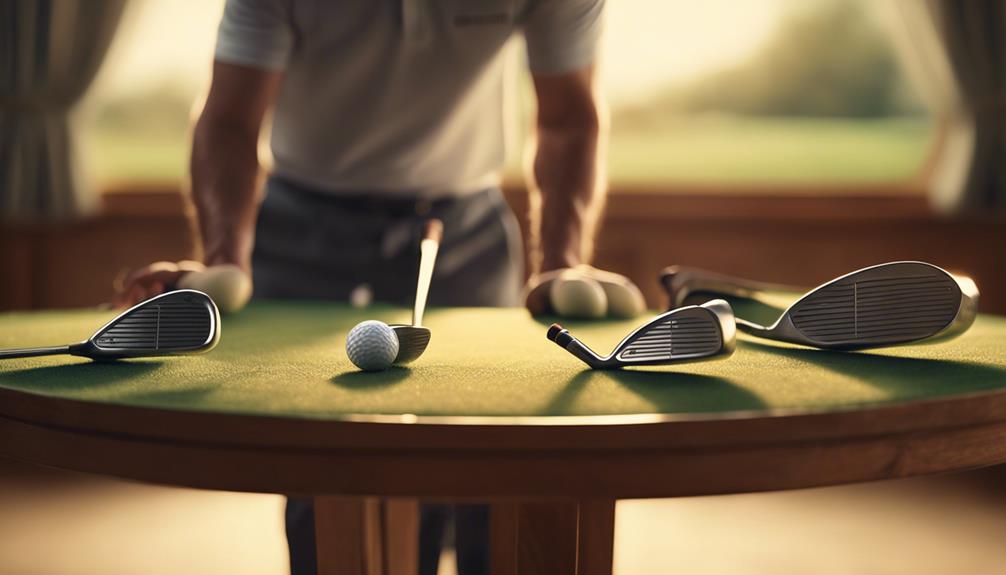
When selecting the perfect golf clubs, it is essential to take into account your unique swing style, playing preferences, and budget, and utilizing buying guides and tips can help streamline the process. To optimize club performance, consider getting fitted by Certified Club Fitters at DICK'S Sporting Goods.
Here are some additional tips to keep in mind:
| Buying Tip | Description |
|---|---|
| Get Fitted | Consult with Certified Club Fitters for optimal club performance |
| Demo Before You Buy | Test clubs before purchasing to ensure they suit your game |
| Start Small | Begin with a half set of beginner clubs for a budget-friendly option |
Pro Tips offers buying guides for fairway woods, hybrids, irons, and putters to aid in club selection. You can also demo different drivers at Owls Nest Resort to find the perfect fit for your game. Remember, testing clubs before purchasing is essential to ensure they suit your playing style and preferences. By following these buying guides and tips, you'll be well on your way to finding the perfect golf club for your unique needs.
Golf Club Fundamentals
Now that you've got the right clubs in your bag, it's time to understand the basics that make them perform at their peak on the course. Mastering golf club fundamentals is essential to improve your game and get the most out of your equipment.
Here are the key elements to focus on:
- Grip thickness: Ensure a comfortable hold for better control, as it affects your swing.
- Shaft length and flex: Match them to your height, body type, and physical strength for prime performance.
- Degrees of loft: Understand that lower lofts result in longer distances, impacting the ball's trajectory.
- Club face: Recognize its role in determining the ball's direction and speed.
- Purpose of each club: Know the specific use of each club in your bag, based on distance, design, and intended use on the course.
Selecting the Right Club for You
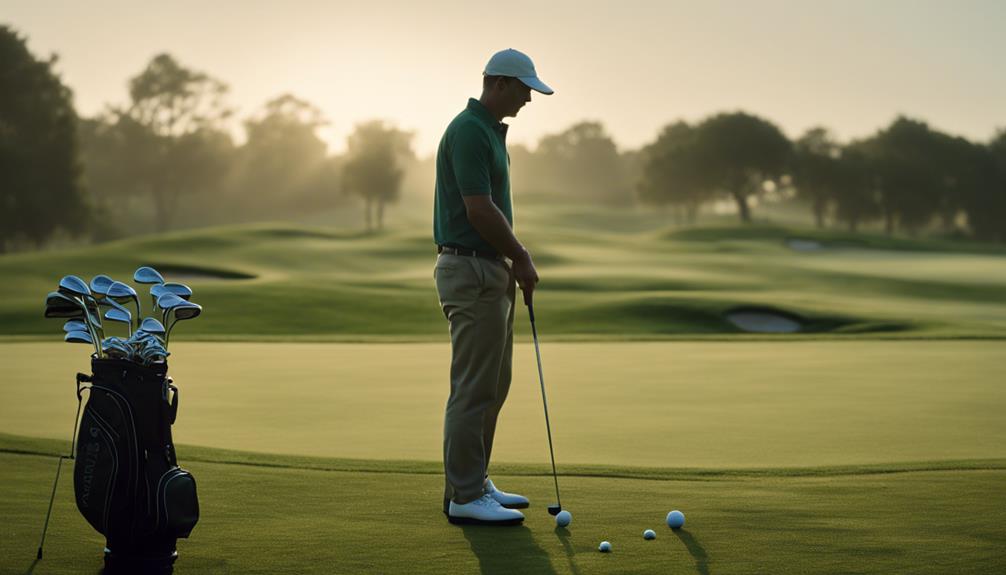
To select the right club for your game, you need to evaluate your unique requirements, including your distance needs and the specific purpose of each club in your bag. This means considering the loft, length, and flex of the club shaft to match your physical characteristics and swing. You want to choose clubs that suit your playing style and skill level, focusing on forgiveness, distance, and control. Remember, the right clubs can help you hit the ball consistently and accurately.
When testing out different clubs, pay attention to how they feel in your hands and how they respond to your swing. You should look for golf gear that provides a comfortable and effective fit. Don't be afraid to try out different clubs before making a purchase. It's better to invest in the right clubs for your game than to settle for ones that don't meet your needs.
Start with a basic set and gradually expand as your game improves to build a personalized set. With the right clubs, you'll be able to take your game to the next level and enjoy the thrill of hitting the ball with precision and power.
Frequently Asked Questions
How Do I Know When to Use the Right Golf Club?
When choosing a club, you'll want to take into account the shot distance, adjusting your swing technique and club angle accordingly, while also factoring in course conditions and grip to guarantee a precise club selection that suits your game.
How Do You Know if a Golf Club Is Right-Handed?
You determine if a golf club is right-handed by checking the grip orientation, clubhead alignment, and shaft configuration; also, consider your grip pressure, swing speed, and club head angle to guarantee a smooth, consistent swing.
How Do You Tell if a Golf Club Is the Right Size for You?
As you stand poised, club in hand, you wonder: is this the one? You check the grip size, ensuring a comfortable fit without strain. Next, you assess the club length, considering your height to avoid hunching. Finally, you factor in your swing speed, seeking the perfect flex.
How Do You Know Which Way You Swing in Golf?
You determine your swing direction by paying attention to grip pressure, swing tempo, and weight distribution – if you're more comfortable addressing the ball from the left, you're likely a right-handed golfer, and vice versa.
Conclusion
As you stand on the green, the sun beating down on your back, you grip your trusty club, feeling the weight of precision in your hands.
You've mastered the art of club selection, and now the course unfolds before you like a canvas waiting for a masterpiece.
With every swing, you paint a picture of perfection, the ball soaring through the air, landing with a soft thud on the lush green.
You've got this – you've got the right club, and the game is yours for the taking.

